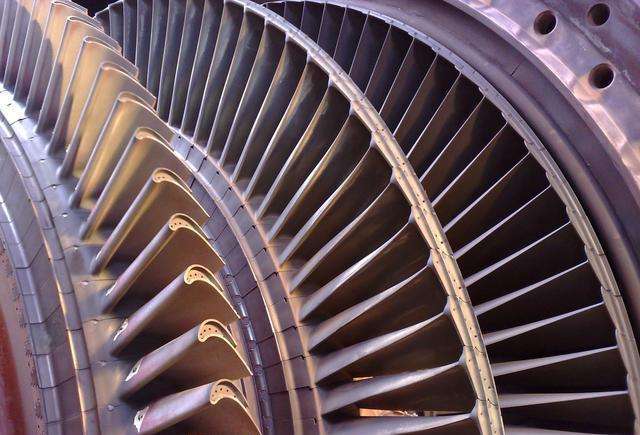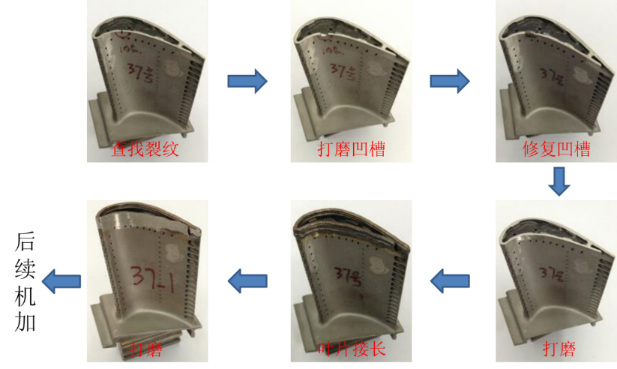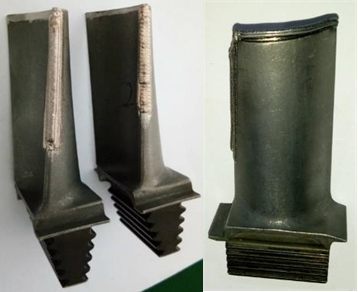
- HOME
- ABOUT US
- PRODUCTS
- SERVICE
- APPLICATIONS
- NEWS
- ABOUT US 2
- PRODUCTS1


SERVICE

当前位置:
High vortex blade repair
发布时间: 2019-09-27 10:17




High-pressure turbine blade
High-pressure turbine blades as key hot-end components are the decisive limiting factor for the minimum life cycle of modern high-performance engines. They are discarded due to the fretting wear of the blade tips and fatigue cracks during use. Burning phenomenon often occurs at the intake side of high vortex blades. Conventional arc welding methods have large heat-affected zones and uncontrollable deformation, which makes it impossible to perform tip repair. Laser additive manufacturing technology can accurately repair blade tip wear and fatigue cracks. At present, in China, there is a lack of systematic basic research on the repairability assessment of hot-end components damaged by aero-engines, the selection and research of repair process methods, and the reliability evaluation of components after repair. Repair technology standards, the critical hot-end components of civil aviation large passenger aircraft engines are completely repaired abroad.
High Vortex Blade Repair
When repairing high-pressure turbine blades, low-melting eutectic phases are prone to form cracks. The thickness of the blade is uneven, the heat accumulation state and temperature gradient of different parts are large, the process window is narrow, and precise energy density control is required to achieve a good molding effect. The working blades of a certain type of high-pressure turbine can achieve the following technical effects:
• The thinnest point of the blade tip reaches 0.3mm;
• "zero" distortion;
• Tight tissue without micro-cracks, pores and other defects;
• The depth of the heat affected zone is not greater than 200 μm
• The performance of the additive material is better than the blade substrate, and the performance reaches or exceeds that of the original part;

Nickel-based superalloys are widely used in the manufacture of turbine blades and guide blades for aviation engines because of their good high-temperature strength and corrosion resistance and long-term use in engine operating environments below 1000 ℃. During the long-term use of aircraft engines, turbine blades may be damaged by wear, impact, high-temperature gas, and hot and cold fatigue, which may cause damage such as cracks, wear, and corrosion, resulting in a large number of blade scraps.

Left: High-vortex blade inlet edge repair process developed by Hui Rui
Right: Burn-in side burn-in and blade tip lengthening laser additive manufacturing repair molding effect
The air intake side and blade tip laser additive manufacturing have a full appearance after molding, no macro cracks, no micro cracks and other defects, and the blade deformation can be controlled.
High-pressure turbine blades as key hot-end components are the decisive limiting factor for the minimum life cycle of modern high-performance engines. They are discarded due to the fretting wear of the blade tips and fatigue cracks during use. Burning phenomenon often occurs at the intake side of high vortex blades. Conventional arc welding methods have large heat-affected zones and uncontrollable deformation, which makes it impossible to perform tip repair. Laser additive manufacturing technology can accurately repair blade tip wear and fatigue cracks. At present, in China, there is a lack of systematic basic research on the repairability assessment of hot-end components damaged by aero-engines, the selection and research of repair process methods, and the reliability evaluation of components after repair. Repair technology standards, the critical hot-end components of civil aviation large passenger aircraft engines are completely repaired abroad.
High Vortex Blade Repair
When repairing high-pressure turbine blades, low-melting eutectic phases are prone to form cracks. The thickness of the blade is uneven, the heat accumulation state and temperature gradient of different parts are large, the process window is narrow, and precise energy density control is required to achieve a good molding effect. The working blades of a certain type of high-pressure turbine can achieve the following technical effects:
• The thinnest point of the blade tip reaches 0.3mm;
• "zero" distortion;
• Tight tissue without micro-cracks, pores and other defects;
• The depth of the heat affected zone is not greater than 200 μm
• The performance of the additive material is better than the blade substrate, and the performance reaches or exceeds that of the original part;

Burnt loss of cast alloy high vortex blades
Nickel-based superalloys are widely used in the manufacture of turbine blades and guide blades for aviation engines because of their good high-temperature strength and corrosion resistance and long-term use in engine operating environments below 1000 ℃. During the long-term use of aircraft engines, turbine blades may be damaged by wear, impact, high-temperature gas, and hot and cold fatigue, which may cause damage such as cracks, wear, and corrosion, resulting in a large number of blade scraps.

Left: High-vortex blade inlet edge repair process developed by Hui Rui
Right: Burn-in side burn-in and blade tip lengthening laser additive manufacturing repair molding effect
The air intake side and blade tip laser additive manufacturing have a full appearance after molding, no macro cracks, no micro cracks and other defects, and the blade deformation can be controlled.

CONTACT US

HOTLINE
025-86756109

Follow us on Wechat





E-Mail:info@huirui-tech.com

Address:No1 Ruixin Road, Jiangning District, Nanjing, JiangSu, China
地址:南京市江宁区瑞鑫路1号
NANJING HUIRUI PHOTOELECTRIC TECHNOLOGY CO., LTD.
Driving freedom of manufactUring
COPYRIGHT © XX import and Export Trading Co., Ltd. copyright all Guangdong 苏ICP备17032011号
Landline:+86-25-86756108



